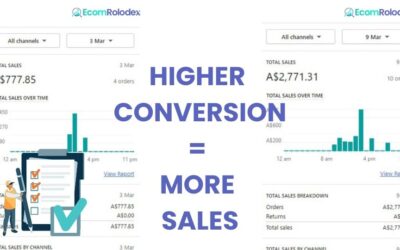1. Who Can Be an Affiliate
- Content creators who focus on e-commerce. (Instagram, Tiktok, Facebook Groups, Youtube)
- Businesses or individuals looking to venture into e-commerce.
- Existing Shopify store owners.
- Providers of related Shopify products or services. (Shopify Apps, Themes, Marketing Agencies, etc.)
- Anyone who wants to refer people looking for Shopify Development and Design services
2. Maximize the In-house Affiliate Platform
- Regularly check the EcomRolodex affiliate dashboard for performance analytics. This will help you optimize your promotional strategies for better conversions.
3. Content Creation
- Articles: Potential titles might include “Top Shopify Experts: Why EcomRolodex Stands Out”, “Revamp Your Shopify Store with EcomRolodex’s Expert Designers”, or “Boosting Conversions: How EcomRolodex Can Transform Your Online Store”.
- Videos: Both short-form (for platforms like TikTok or Instagram) and long-form (for YouTube or webinars) videos explaining the benefits of using EcomRolodex.
4. Leverage Social Media
- Quick Posts: A simple Facebook or Twitter post about a positive experience with EcomRolodex or highlighting a feature of the Epic theme.
- Stories & Highlights: Use Instagram or Facebook stories to showcase behind-the-scenes looks at EcomRolodex services.
5. Email Marketing
- A dedicated email campaign introducing EcomRolodex’s services.
- Include it as a recommendation in a broader e-commerce tips newsletter.
6. Embed Affiliate Links on Websites
- If an affiliate has a website, they can create a dedicated section or page recommending EcomRolodex. This can be under titles like “Resources We Recommend” or “Our Trusted Partners”.
- Add banners or sidebar ads showcasing EcomRolodex services.
7. Promote the Unique Services
- Highlight specific services like Development and Design Packages, Conversion Optimization Services, and the Epic theme to cater to varied audience needs.
8. Engage in Community Discussions
- Participate in e-commerce or Shopify-related forums, Facebook groups, and LinkedIn discussions. Answer questions and subtly recommend EcomRolodex when relevant.
9. Partnership & Trust
- Position the affiliate relationship as a partnership. This not only adds credibility but also ensures that potential clients see the recommendation as coming from a place of trust.
- Always disclose the affiliate relationship to maintain transparency and trustworthiness.
10. Collaborate with Other Shopify Product Sellers
- Engage with those who sell Shopify themes, apps, and other related products. A mutual recommendation system can be beneficial. For instance, someone selling a Shopify app can recommend EcomRolodex for design services and vice versa.
11. Stay Updated
- With the evolving nature of e-commerce, it’s crucial for affiliates to stay updated with any new services or features introduced by EcomRolodex. This ensures that their promotional content remains relevant and up-to-date.
12. Testimonials & Success Stories
- Share stories of satisfied EcomRolodex clients. Real-world success stories resonate more with potential clients and can significantly boost credibility.
Check out services and portfolio here →In conclusion, promoting EcomRolodex effectively requires a mix of content creation, community engagement, and leveraging the power of partnerships and trust. By focusing on the unique offerings of EcomRolodex and the needs of the target audience, affiliates can achieve successful conversions.
Signup as an affiliate today →
Start with low-hanging fruit
- New Shopify Store Owners: Those who’ve just set up their Shopify store but lack the technical expertise to customize or optimize it.
- Existing Shopify Store Owners with Poor Performance: Store owners who have low conversion rates, slow load times, or other performance issues.
- Businesses Switching to Online Sales: Brick-and-mortar businesses looking to transition to online sales, especially given the current trend towards e-commerce.
- E-commerce Stores on Other Platforms: Businesses using platforms other than Shopify (like WooCommerce, Magento, etc.) but considering a switch to Shopify.
- Shopify Store Owners with Outdated Designs: Those with outdated or non-responsive designs that aren’t mobile-friendly.
- Businesses Expanding Their Product Line: Stores that are expanding and need to restructure their website to accommodate new product categories or features.
- Dropshipping Entrepreneurs: Many newcomers to e-commerce start with dropshipping on Shopify and often need assistance setting up or optimizing their stores.
- Businesses with Poor SEO: Stores struggling with organic visibility on search engines due to poor SEO practices.
- Shopify Stores with Poor User Experience: Websites that have received customer feedback about difficult navigation, confusing checkout processes, or other user experience issues.
- Brands Looking for Custom Features: Those wanting to implement custom features or integrations that aren’t available with default Shopify functionalities or apps.
- Businesses Seeking International Expansion: Stores looking to cater to international audiences and needing multi-language or multi-currency features.
Reaching out to these “low hanging fruit” segments with tailored messaging about the benefits of Shopify development and optimization services can result in quicker conversions and business growth.



